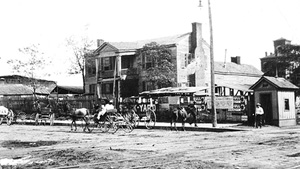
These names have recently been added to our page that lists locations that were given the names of early pioneers and settlers in the area.
François Marie Cantagrel (Cantegral Street) was the first director of the La Reunion community, which was an experimental socialist community located south and west of the Trinity River across from what was then the small town of Dallas. Cantagrel (also spelled Cantegral) was a close associate of Victor P. Considerant, the primary organizer of the colony which existed for two to three years in the mid to late 1850s. Cantegral Street as it now remains, is only four to five blocks long and runs from Bryan Street to Gaston Avenue just northeast of downtown. Other cross streets are Live Oak, Florence and Swiss Avenue.
John H. Cole (Cole Avenue) was a medical doctor and pioneer of Dallas County. He was born in Virginia in 1795 and was a veteran of the War of 1812. He married the former Polly McDonald. After first living in Tennessee and then in Arkansas, the family moved to Texas, initially settling in Crawford and later Washington County before relocating to what became Dallas County while it was still part of Nacogdoches County. The family settled in Cedar Springs where Dr. Cole farmed and set up his medical practice. He died in 1850 and his wife followed him in death in 1869. Both are buried in Greenwood Cemetery.
Lafayette Henry Fitzhugh (Fitzhugh Avenue) was an investor and board member in various railroad companies including the Chicago, Texas and Mexican Central Railway, a narrow gauge line which operated under that name for only a couple of years, from 1880 to 1882 before being acquired by another railway company that converted it to standard gauge. In Austin, he owned a hotel called the Fitzhugh House that was near the Houston and Texas Railroad terminus. He also owned a home and acreage in East Dallas. Ironically, L. H. Fitzhugh (1830-1905) died on a train while in route to a home for disabled veterans in Ohio. His remains were returned to Dallas where he was interred in Greenwood Cemetery. We also learned that there is support for the street having been named for his son, Judge L. H. Fitzhugh, Jr. (1858-1938), and will keep researching the matter. Judge Fitzhugh is buried at Oakland Cemetery.
General Richard Montgomery Gano (Gano Street) came to Texas before the Civil War first settling in Tarrant County and coming to Dallas County after the conflict. During his career, he practiced as a medical doctor, served as a minister and also was a stockman, farmer and banker. He was born in Bourbon County, Kentucky in 1830 and died in Dallas County in 1913. He is buried in Oakland Cemetery in Dallas.
John Grigsby (Grigsby Avenue) is the namesake for the street which now runs on a southwesterly direction between Ross Avenue and Gaston Avenue. It appears to be the remaining Dallas street or landmark named for John Grigsby (1787-1841) out of a 4,605 acre plot of land grant perfected posthumously to Grigsby’s heirs by Sam Houston in 1842. Grigsby’s grant and that of John Neely Bryan made up much of early Dallas. A family genealogy summary called “Early Texas Grigsbys” says, “Our Grigsby ancestors came to Texas from Illinois in 1834 following the promise of abundant land for farming, game and fish for food, timber for housing and fuel. They probably came with covered wagons drawn by teams of horses, mules, or oxen. The head of the family, John Grigsby (ca. 1787-1841), and his second wife, Elizbeth Louisa, joined the Pilgrim Predestinarian Church in Houston (now Anderson) County in 1836, and he served as clerk for many of the subsequent meetings of the congregation. His large land grant in what is now downtown Dallas was issued in 1838 and patented in 1842 (after Grigsby’s death) by Sam Houston.” John Grigsby himself never resided in Dallas, since he had died just before the land grant was patented.


